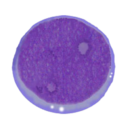Recognition of APL differentiation
From haematologyetc.co.uk
Recognition of acute promyelocytic leukaemia
Typical APL has cells that are hypergranular (A) or may be the microgranular variant (B) generally the cells will have a range of granulation or nuclear appearance. While CD45 expression tends to be weak, in almost all cases the variable morphological features cause a wide range of side-scatter with the abnormal cells often forming a "cloud" extending toward the neutrophil area. This can make the cells (particular hypergranular forms) difficult to distinguish from reactive myeloid populations (or occasionally from MDS). Absent HLA-DR on APL cells can help distinguish from reactive cells (expressing HLA-DR), but correlation with morphology and clinical features and other confirmatory tests are essential to the recognition of APL.
